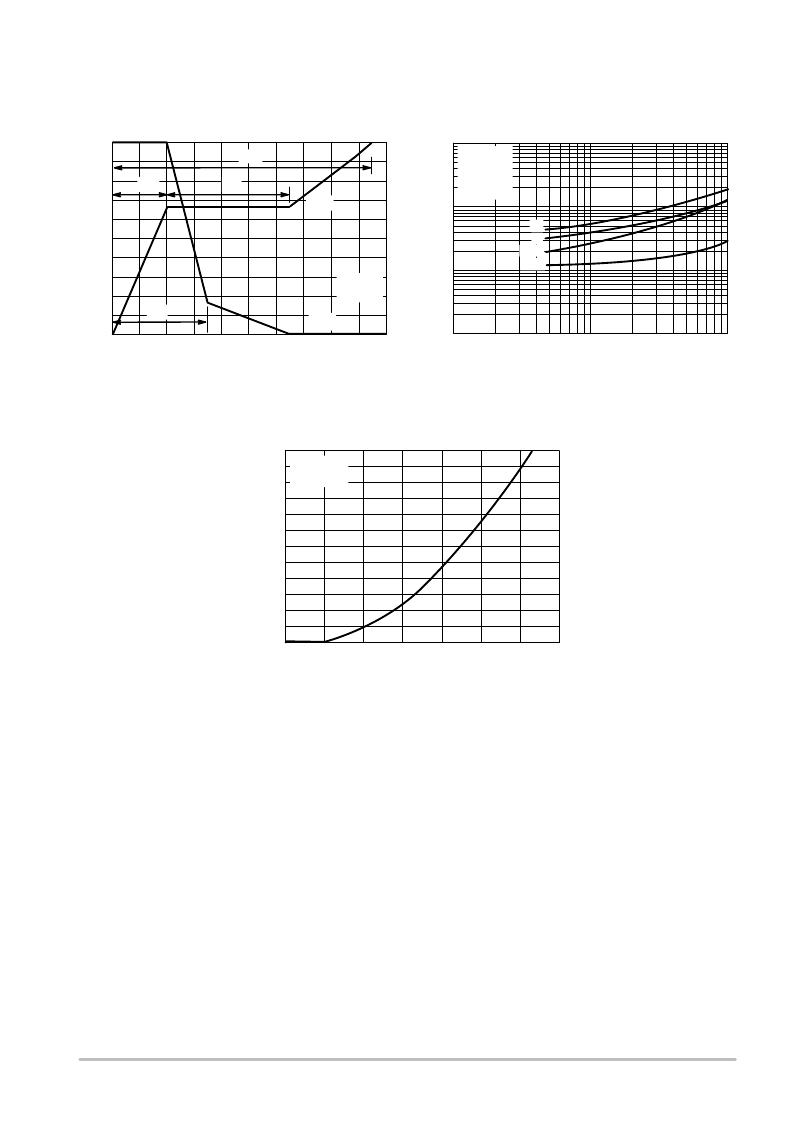- 您現在的位置:買賣IC網 > PDF目錄383646 > MTD2955VT4G (ON SEMICONDUCTOR) 30V N-Channel PowerTrench MOSFET PDF資料下載
參數資料
| 型號: | MTD2955VT4G |
| 廠商: | ON SEMICONDUCTOR |
| 元件分類: | 功率晶體管 |
| 英文描述: | 30V N-Channel PowerTrench MOSFET |
| 中文描述: | 12 A, 60 V, 0.23 ohm, P-CHANNEL, Si, POWER, MOSFET |
| 封裝: | LEAD FREE, CASE 369C-01, DPAK-3 |
| 文件頁數: | 5/10頁 |
| 文件大小: | 85K |
| 代理商: | MTD2955VT4G |

MTD2955V
http://onsemi.com
5
DRAINTOSOURCE DIODE CHARACTERISTICS
Figure 8. GateToSource and DrainToSource
Voltage versus Total Charge
Figure 9. Resistive Switching Time
Variation versus Gate Resistance
Figure 10. Diode Forward Voltage versus Current
V
V
R
G
, GATE RESISTANCE (OHMS)
1
10
100
t
V
DD
= 30 V
I
D
= 12 A
V
GS
= 10 V
T
J
= 25
°
C
t
f
t
d(off)
t
d(on)
0
Q
T
, TOTAL CHARGE (nC)
2
4
6
8
20
I
D
= 12 A
T
J
= 25
°
C
V
GS
1000
100
10
1
10
6
2
0
1
8
4
30
27
24
21
18
15
0
V
DS
18
14
QT
Q1
Q2
Q3
16
10
12
t
r
7
3
9
5
12
3
6
9
0.5
0.7
1.1
1.9
V
SD
, SOURCETODRAIN VOLTAGE (VOLTS)
I
V
GS
= 0 V
T
J
= 25
°
C
0
6
8
10
12
4
0.9
1.3
1.5
2
1.7
5
7
9
11
3
1
SAFE OPERATING AREA
The Forward Biased Safe Operating Area curves define
the maximum simultaneous draintosource voltage and
drain current that a transistor can handle safely when it is
forward biased. Curves are based upon maximum peak
junction temperature and a case temperature (T
C
) of 25
°
C.
Peak repetitive pulsed power limits are determined by using
the thermal response data in conjunction with the procedures
discussed
in
AN569,
ResistanceGeneral Data and Its Use.”
Switching between the offstate and the onstate may
traverse any load line provided neither rated peak current
(I
DM
) nor rated voltage (V
DSS
) is exceeded and the
transition time (t
r
,t
f
) do not exceed 10 s. In addition the total
power averaged over a complete switching cycle must not
exceed (T
J(MAX)
T
C
)/(R
JC
).
A Power MOSFET designated EFET can be safely used
in switching circuits with unclamped inductive loads. For
“Transient
Thermal
reliable operation, the stored energy from circuit inductance
dissipated in the transistor while in avalanche must be less
than the rated limit and adjusted for operating conditions
differing from those specified. Although industry practice is
to rate in terms of energy, avalanche energy capability is not
a constant. The energy rating decreases nonlinearly with an
increase of peak current in avalanche and peak junction
temperature.
Although many EFETs can withstand the stress of
draintosource avalanche at currents up to rated pulsed
current (I
DM
), the energy rating is specified at rated
continuous current (I
D
), in accordance with industry
custom. The energy rating must be derated for temperature
as shown in the accompanying graph (Figure 12). Maximum
energy at currents below rated continuous I
D
can safely be
assumed to equal the values indicated.
相關PDF資料 |
PDF描述 |
|---|---|
| MTP | Wet Tantalum Capacitors Subminiature, Axial Leads |
| MTP156K00691D | Wet Tantalum Capacitors Subminiature, Axial Leads |
| MTP156M00691D | Wet Tantalum Capacitors Subminiature, Axial Leads |
| MTZJ5.1 | 500mW Zenor Mini Diode |
| MTZJ10 | 500mW Zenor Mini Diode |
相關代理商/技術參數 |
參數描述 |
|---|---|
| MTD2N20 | 制造商:MOTOROLA 制造商全稱:Motorola, Inc 功能描述:POWER FIELD EFFECT TRANSISTOR N-CHANNEL ENHANCEMENT-MODE SILICON GATE |
| MTD2N40E | 制造商:ON Semiconductor 功能描述:Trans MOSFET N-CH 400V 2A 制造商:Rochester Electronics LLC 功能描述:- Bulk |
| MTD2N40ET4 | 制造商:Rochester Electronics LLC 功能描述:- Bulk |
| MTD2N50 | 制造商:MOTOROLA 制造商全稱:Motorola, Inc 功能描述:POWER FIELD EFFECT TRANSISTOR N-CHANNEL ENHANCEMENT-MODE SILICON GATE DPAK FOR SURFACE MOUNT OR INSERTION MOUNT |
| MTD2N50E | 制造商:MOTOROLA 制造商全稱:Motorola, Inc 功能描述:TMOS POWER FET 2.0 AMPERES 500 VOLTS RDS(on) = 3.6 OHM |
發(fā)布緊急采購,3分鐘左右您將得到回復。